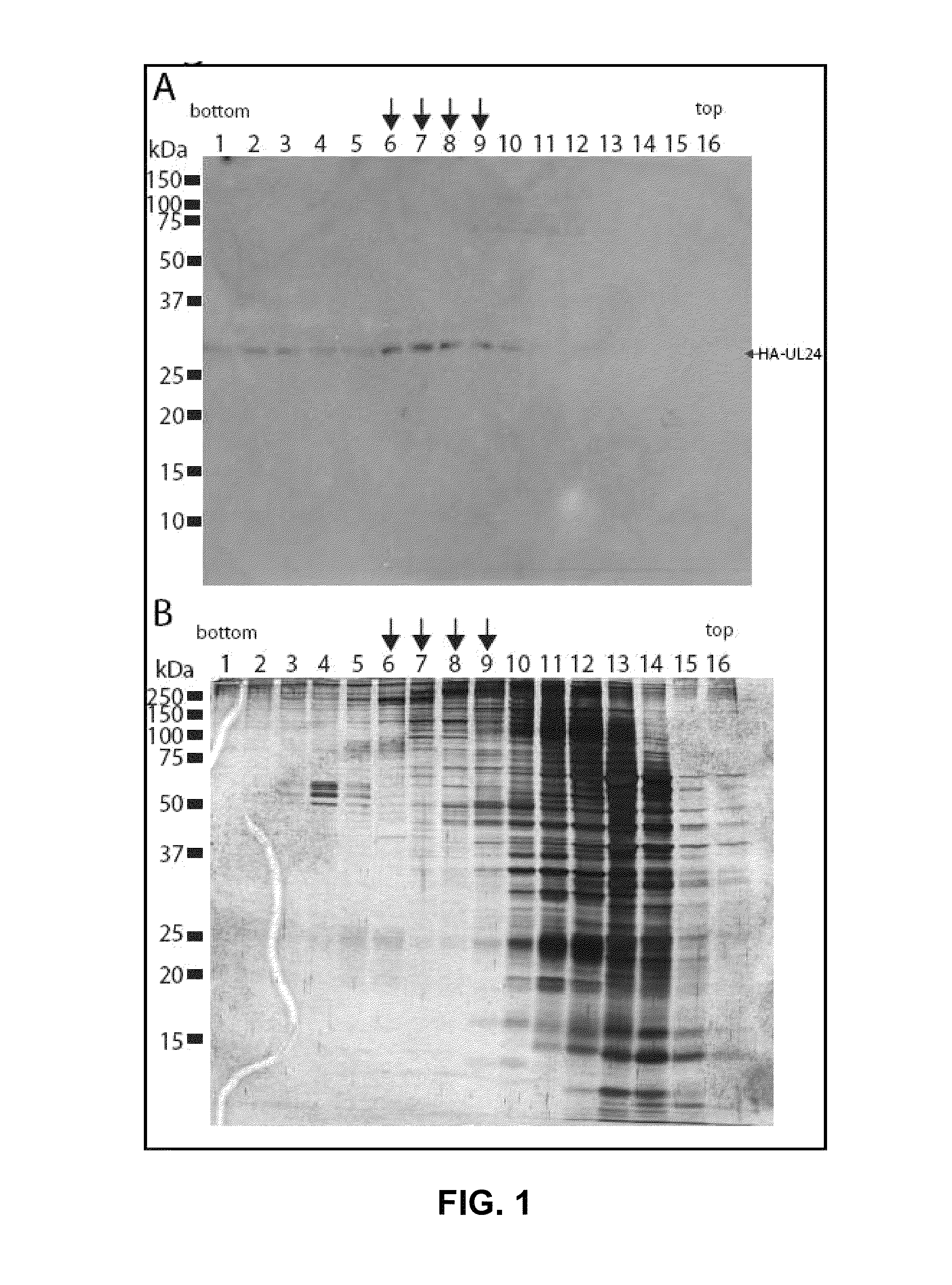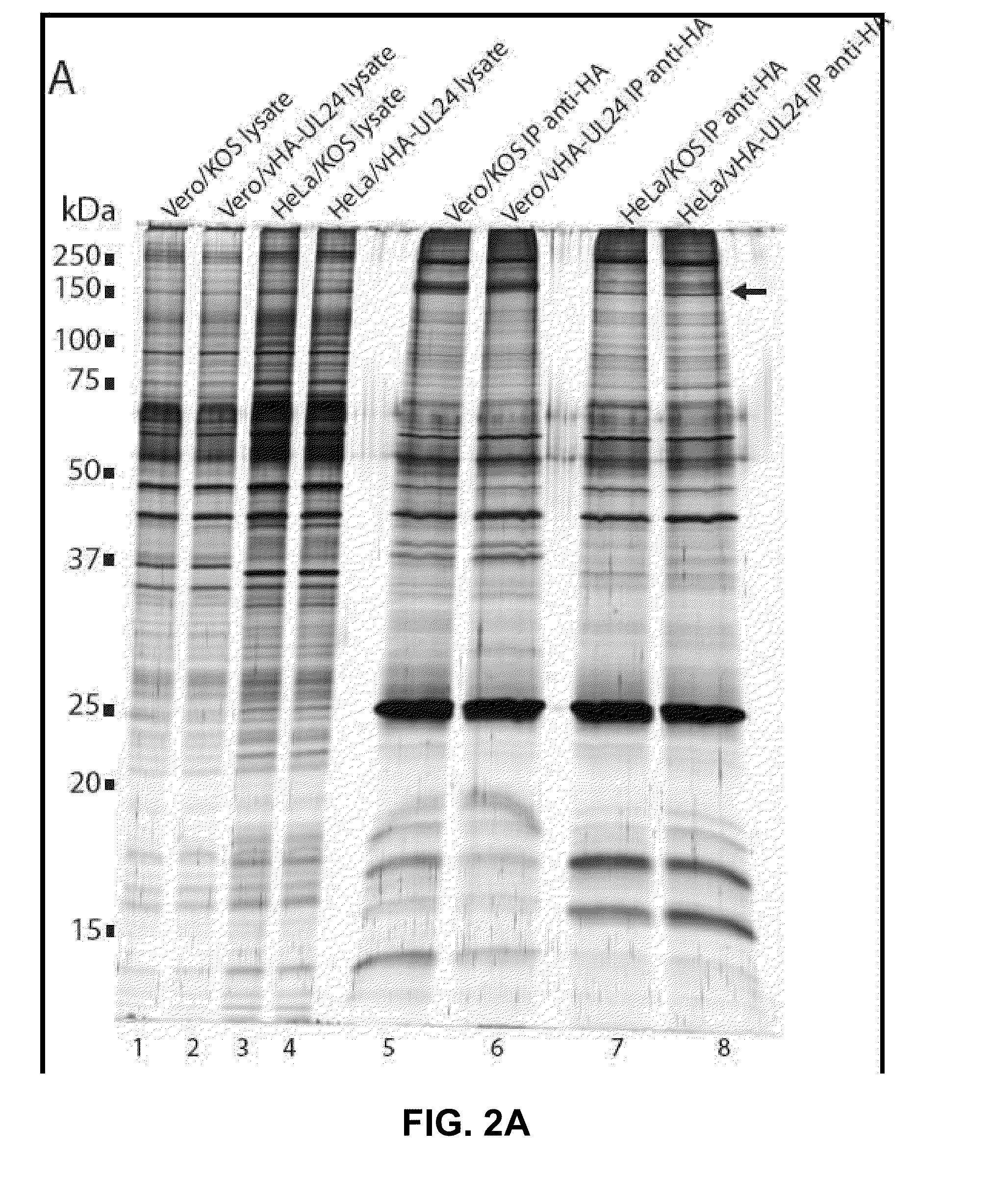Modulation of UL24 interactions with protein targets and uses thereof for inhibition of herpesvirus infection
a technology of protein target and ul24, which is applied in the field of modulation of ul24 interactions with protein target, can solve the problems of unregulated cell-cell fusion, decreased viral replication efficiency, and/or viral spread
- Summary
- Abstract
- Description
- Claims
- Application Information
AI Technical Summary
Benefits of technology
Problems solved by technology
Method used
Image
Examples
example 1
Material and Methods
[0094]Cell Culture and Viruses.
[0095]Vero cells (African green monkey kidney fibroblasts) were propagated in Dulbecco's Modified Eagle Medium (DMEM) (Invitrogen) supplemented with 5% newborn calf serum (NCS) (Invitrogen), 50 U / ml of penicillin and 50 μg / ml of streptomycin (Invitrogen). HeLa cells were cultured in DMEM with 8% foetal bovine serum (FBS) (Invitrogen) with the same concentration of antibiotics. Infections were carried out in DMEM with 2% NCS and the same concentration antibiotics. The HSV-1 strain KOS and UL24X (Jacobson, J. G., et al. 1998. Virology 242:161-9) were originally provided by D. M. Coen. The strain vHA-UL24, which was constructed in a KOS background, has been described previously (Lymberopoulos, M. H., and A. Pearson. 2007. Virology 363:397-409).
[0096]Human Foreskin Fibroblast (HFF) were obtained from the American Type Culture Collection (ATCC). Cells were maintained in Dulbecco's modified Eagle's medium (DMEM) supplemented with 10% (v / v...
example 2
UL24 of HSV-1 is Present in High Molecular Weight Protein Complexes
[0113]To determine if UL24 had interacting partners, extracts from HSV-1-infected HeLa cells were fractionated on glycerol gradients to see if a portion of UL24 sedimented at a higher molecular weight then that corresponding to its predicted molecular weight, which would indicate an association with other proteins. Cells were infected for 18 hours with the virus vHA-UL24 (Lymberopoulos, M. H., and A. Pearson. 2007. Virology 363:397-409), which expresses UL24 with an N-terminal hemagglutinin (HA) affinity tag. This virus replicates like the wild-type parental virus KOS, and does not form syncytial plaques. Whole cell extracts were applied to a 8%-25% continuous glycerol gradient. Following centrifugation, gradients were separated in 16 fractions. Samples of each fraction were resolved by SDS-PAGE, and were analyzed by Western blotting using an antibody directed against HA (FIG. 1A). As a control for the efficacy of th...
example 3
NM2a Co-Precipitates with HA-UL24
[0114]To identify the proteins present in the UL24 complex, HA-UL24 was immunoprecipitated (IP) using an anti-HA matrix. Whole cell extracts prepared from either KOS- or vHA-UL24-infected cells, were used for immunoprecipitation using an antibody directed against HA. The precipitated proteins were separated by SDS-PAGE, and visualized by staining with silver (FIG. 2A). A band, between the 150 and 250 kDa protein markers, that was specific for the HA co-IP performed on extracts from HeLa cells infected with vHA-UL24 was observed. This band was not detected when extracts of cells infected with KOS were used. It was not possible to discern if a similar band was present in the anti-HA IP performed on infected Vero cell extracts due to the presence of non-specific bands in the same area on the gel. The specific band was excised from the gel and subjected to tryptic digest, and the resulting peptides were identified by mass spectrometry. The results indica...
PUM
| Property | Measurement | Unit |
|---|---|---|
| temperature | aaaaa | aaaaa |
| temperature | aaaaa | aaaaa |
| temperature | aaaaa | aaaaa |
Abstract
Description
Claims
Application Information
 Login to View More
Login to View More - R&D
- Intellectual Property
- Life Sciences
- Materials
- Tech Scout
- Unparalleled Data Quality
- Higher Quality Content
- 60% Fewer Hallucinations
Browse by: Latest US Patents, China's latest patents, Technical Efficacy Thesaurus, Application Domain, Technology Topic, Popular Technical Reports.
© 2025 PatSnap. All rights reserved.Legal|Privacy policy|Modern Slavery Act Transparency Statement|Sitemap|About US| Contact US: help@patsnap.com



